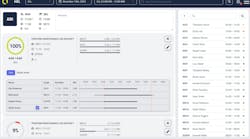You may think this article unusually optimistic, considering the current economic environment. However, we can rest assured that, unless technology makes a huge leap to instant transporter devices, we will continue using airplanes to move lots of people and cargo. In the past 20 years air travel grew around 4.8 percent per year. During those 20 years we had a variety of financial crises, major world recessions, escalating fuel prices, and a host of conflicts around the world. The growth for the next 20 years is predicted to be about 5 percent. Further, as of 2007 there were about 19,000 main line and regional jets in service, and if projections hold, there will be around 36,000 by 2027. So, optimistic? Sure, but we can all use a little sunshine right now.
Here is the challenge for the new guys and gals. With the projected growth over the next 20 years, there will always be a given distribution of mechanics entering and exiting the work force. The challenge for entry-level A&Ps is that they have to buy tools to perform their jobs. This has always struck me as an upside down process because entry-level A&Ps have to purchase their required tools with their equally entry-level wages. I hadn’t bought tools in a while, and recently found out how unbelievably expensive hand tools are. Last Christmas I bought a stubby 3/8-inch drive ratchet and paid way north of $75. While staring at my receipt, I was reminded of the costs that entry-level A&Ps incur to properly equip themselves. The process seems backwards because sometimes they have to go into debt to meet their job requirements. This started me thinking about how to help entry-level A&Ps build their minimum tools list without breaking the bank.
Buy what you need when you need it
The following are some general tool buying guidelines that will work in a variety of aviation work environments.
1. Start slow and be frugal. Buy only what you need to do your job. The place you work, your specialty, and the type(s) of aircraft that you maintain determine the tools you need.
2. Ask questions and take the advice of your peers before you purchase. You can get tool lists from A&P schools, employers, the union hall, and from reliable vendor representatives. Take advantage of assistance offered by vendor discounts and payroll deduction purchase plans.
3. After talking to other A&Ps and looking at required or recommended tool lists, you have to develop a purchasing plan. Some new mechanics start at Sears, and buy a big shiny roll-away and a general mechanics tool set and call it done. The best rule is to buy what you need and the best you can afford. Always buy quality tools that are backed by a good guarantee. Use your tools safely and always replace worn or broken tools.
Hope this helps. Always treat your tools with care and respect, because they represent you and your profession.
I am sorry to say, but I haven’t found that perfect tool list. But what I can offer is a general tool list that can help get you started. It is organized by category or specialty that has served A&P mechanics in a variety of work environments. It is based on experience and the opinions from those of us who have “been there and done that.”
General mechanics tools
• Standard screwdriver set in common lengths and sizes
• Combination wrench set in sizes from ¼ to 1 inch
• 3/8-inch drive ratchet set with extension
• 3/8-inch drive deep 12 point socket set in common sizes
• ½-inch drive ratchet set with extensions in common sizes
• ½-inch drive deep 12 point socket set in common sizes
• 3/8-inch drive breaker bar
• ½-inch drive breaker bar
• 3/8-inch drive speed handle
• ½-inch drive speed handle
• 3/8-inch drive adjustable air-driven impact
• Adjustable jaw wrenches (large and small)
• Set of Allen wrenches
• Set of common pliers
• Set of vice grips (large and small)
• Set of Channel locks (large and small)
• Safety wire twisters
• Two dead blow hammers (large and small)
• Two ball peen hammers (large and small)
• Safety glasses
• Hard shell ear protectors
• Set of feeler gauges
• Pair of mechanical fingers
• Adjustable mirror
• Long handler magnet
• 10X magnifying glass
• Industrial handheld and head band type flashlights
• Hack saw
• Utility knife
• Mechanics tool chest
• Roll-away
Avionics and electrical tools
• Small toolbox or canvas tool bag
• Side cut pliers
• Needle nose pliers
• Cannon plug pliers
• Male and female pin pushers
• Industrial handheld and head band type flashlights
• Wire strippers
• Crimpers
• Digital volt ohm meter with leads
• 10X magnifying glass
• Utility knife
• Screwdrivers and nut driver set
• Soldering iron 40W maximum
• Safety glasses
• Small ball peen hammer
• Safety wire twisters
Structural repair tools
• Dead blow hammers
• Rawhide mallet
• Ball peen hammer
• ¼-inch chuck pistol grip air drill (2,600 rpm, 33 hp, non reversible)
• Drill bit set (high speed 135-degree with split point and in common rivet sizes)
• 4X pistol grip rivet gun with beehive retaining spring
• Adjustable pistol grip air screwdriver
• Universal rivet set (straight and offset in common rivet sizes)
• Flush rivet set (one large for skins and one smaller)
• 3 bucking bars (1.5- to 3-pound bars, include a stringer bar, heel and toe, and a z bar)
• Micro stop countersink with piloted cutters (cutters in common rivet sizes)
• Cleco pliers and clecos (two dozen each in silver, black, copper, gold, and side clamping)
• Hole finders (in common rivet sizes)
• Combination square set
• Inside and outside calipers
• Scribe
• 8-inch shockproof dial calipers
• Set of radius gauges
• Set of feeler gauges
• Pin punches (in common rivet sizes)
• Automatic center punch
• ½-inch chisel
• Straight snips
• Files (flat, half round and round)
• File handle
• Left and right snips
• Hack saw
• 10-foot steel measuring tape
• Needle nose vice grips
• Allen wrenches
• Screw extractor
• Safety glasses
• Hard shell ear protectors
• Hip type toolbox with top tray
Managing your tool inventory
After your purchases, carefully managing your valuable tools inventory will bring peace of mind. You can minimize the risk of misplacing tools by taking only what you need to do the job. A problem with owning a large inventory of expensive tools is that you also have to manage that large inventory of tools. This requires a secure place to store your tools so that you don’t have what retailers call “mysterious shrinkage.” To avoid loss of tools, at the end of every shift you must, without fail, account for each tool used during the shift. The more tools you take to the job site, the more likely you are to misplace or forget one. From day one, you need to develop a failsafe strategy of ensuring that you bring home all the tools that you took to the job.
When do you replace worn and broken tools? Don’t think about it, just do it. Practice tools safety, and always replace or repair worn or broken tools.




